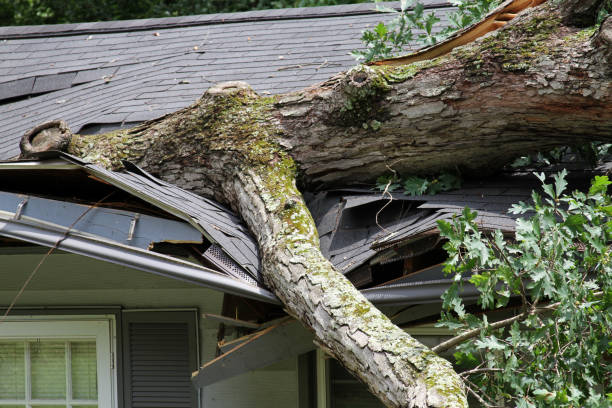Shielding your home from the elements begins at the top – with your roof. Be it against the scorching rays of the sun or the relentless downpour of rain, your roof will always stand as your home’s first line of defense. In order to properly protect your roof, you must understand the common culprits that threaten your roof’s integrity. You need to be able to identify potential dangers to your roof like those wayward branches seeking refuge, the unrelenting march of time itself, etc. To address that, this article explores the practical ways to protect your roof against the everyday adversaries that seek to compromise its protection.
-
UV Rays
The rays from the sun pose a significant threat to your roof’s well-being, especially when it becomes very harsh.
Just like the way Ultraviolet radiation (UV rays) tends to cause sunburn and cancer risks for your skin, it also inflicts a comparable toll on your roofing materials. Day after day, these harmful rays tirelessly beat up your roof and cause your shingles to dry up.
The top layer of your roof material bears the bigger part of the sun beating. Eventually, this top layer will start succumbing to exposure.
When the top layer starts peeling off, it jeopardizes your roof’s structural integrity.
If you want to protect your roof from the harsh rays of the sun, you will need to employ a thoughtful approach. Firstly, opt for UV-resistant roofing materials to mitigate the impact of direct sunlight.
You can also apply a reflective coating to deflect UV rays and reduce heat absorption.
Another procedure you can follow is to constantly ensure adequate ventilation. This will help with temperature regulation, and it will prevent excessive heat-induced stress.
-
Damaged or Missing Shingles
Preserving the structural integrity of your roof depends on safeguarding its crucial components – particularly the shingles.
As the first line of defense against sunlight, heat, storms, and more, shingles are prone to wear and tear. Missing or damaged shingles expose your home to water damage, mold, and rot.
When this happens, it sets the stage for a domino effect of deterioration.
Hence, it is important that you carry out regular inspections, so you can quickly identify loose or missing shingles or signs of weather or animal damage.
The moment you notice any issue with your shingles, you should promptly address the issues by replacing or sealing affected shingles.
Another measure to take is to clean accumulated debris. This will help ensure the longevity and reliability of your roof.
-
Mold and Algae
It is important that you fight against the invasion of mold and algae if you want to preserve your roof’s vitality. Mold and algae can significantly diminish performance and longevity if you ignore them for a long time.
Eventually, they will cause damage that requires costly repairs.
If you don’t know how to spot them, it’s quite easy. Mold is recognizable by its pungent odor and unsightly dark blotches. It tends to thrive in moist environments, particularly on wood and drywall surfaces.
Similarly, algae grow as green, black, or blue-green stains. They are so unsightly that a tiny one of them damages your roof’s appearance and integrity.
Vigilance is key, so you will need to conduct regular inspections. Regular inspections can help you to identify early signs, so you know to take preventive measures.
Proactive actions, such as addressing moisture issues and promptly cleaning affected areas, are a great way to combat mold and algae.
-
Overhanging Trees
While trees bring numerous benefits, their overhanging branches pose potential threats to your roof. Though they shield against high winds and provide UV protection, weakened or damaged trees pose a risk of falling during storms.
Just like the way they can scratch and damage your window; branches can damage roofing materials if blown off during a storm. Additionally, the seasonal shedding of leaves creates rooftop chaos that tends to lead to clogged gutters and valleys.
Beyond the immediate damage, the accumulation of debris fosters mold, moss, and algae growth. The effect of all of this is that it diminishes your roof’s vibrancy and longevity.
To avoid this issue, you will need to regularly prune and maintain the trees around your home. Ensure to always remove debris from your roof in order to prevent excess accumulation and the growth of mold, moss, and algae.
-
Damaged Flashing
The roof flashing comprises metal strips along seams and edges, that serve as a crucial barrier against the penetration of water.
Flashings are always present in roof valleys, chimneys, and areas requiring added water protection. If your roof’s flashing is cracked or bent upwards, it means there’s trouble somewhere.
In heavy rains, water will be able to infiltrate the roof seams, leading to potential leaks.
You should know that despite their steel or aluminum composition, flashings are not invincible. They are susceptible to cracks, warping, and complete blow-offs.
These damages are often due to improper installation or weather exposure and rust induced by sea air. If you want to avoid this issue, you will need to be highly vigilant.
Conduct periodic inspections and timely repairs to protect your roof against the dangers of damaged flashing.
Conclusion
As you embark on the journey of protecting your shelter, consider the expertise of ShorelineRoofing. With a commitment to excellence, our services encompass the spectrum of roof care, and it ensures that your roof is resilient against common causes of damage.
Trust Shoreline Roofing to be your partner in preserving the integrity of your roof. Contact us today for a roofing experience beyond compare.

